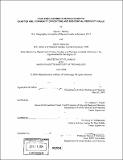| dc.contributor.advisor | Langley C. Keyes and Henry R. Pollakowski. | en_US |
| dc.contributor.author | Ritchay, David J. (David James), 1976- | en_US |
| dc.contributor.author | Weinrobe, Zoe R. 1977- | en_US |
| dc.contributor.other | Massachusetts Institute of Technology. Dept. of Urban Studies and Planning. | en_US |
| dc.coverage.spatial | n-us-ma | en_US |
| dc.date.accessioned | 2005-06-02T18:20:36Z | |
| dc.date.available | 2005-06-02T18:20:36Z | |
| dc.date.copyright | 2004 | en_US |
| dc.date.issued | 2004 | en_US |
| dc.identifier.uri | http://hdl.handle.net/1721.1/17709 | |
| dc.description | Thesis (M.C.P.)--Massachusetts Institute of Technology, Dept. of Urban Studies and Planning, 2004. | en_US |
| dc.description | Also issued with b&w images. | en_US |
| dc.description | Includes bibliographical references (p. 205-208). | en_US |
| dc.description.abstract | This thesis asks and answers an important question in the heated debate concerning M.G.L.c. 40B, the state's Comprehensive Permit Law: "Do large-scale, high-density Chapter 40B multi- family rental developments negatively impact nearby single-family property values in suburban Boston communities?" We ask the question because of the widespread belief that one of the strongest motives for resident opposition to 40B projects is the fear that homes values surrounding these multi-family developments will decrease. In an effort to resolve the debate, we design a rigorous research methodology to examine the impact of introducing a large-scale multi-family rental development into a neighborhood of single-family homes. We develop strict case selection criteria that identify nine 40B developments located in eight suburban communities. These case studies represent some of the most egregious, controversial, and dense Chapter 40B developments in the Boston metropolitan area; in other words, a suburbanite's worst nightmare. After selecting the cases, we establish conservative impact areas, which include only the single-family homes mostly likely to be affected by each respective 40B development. Our process for identifying impact areas restricts the boundaries to essentially abutters and immediate neighbors of each of the nine developments. The purpose for carefully establishing such impact areas is to objectively measure single-family home price changes over time as 40B developments are announced, approved, constructed, occupied, and integrated into the resident communities. | en_US |
| dc.description.abstract | (cont.) We use hedonic (econometric) modeling to create comparative house price indexes for each impact area along with an appropriate control area (the remainder of the host community) to determine whether a decrease in home values has occurred over time within such impact areas. The results of all nine case studies conclude that the introduction of large-scale, high-density 40B multi-family rental developments in single-family neighborhoods does not affect the value of adjacent homes. While it may seem reasonable, our findings show that, in fact, the "rational economic" fear of potential asset value loss among suburban homeowners is misplaced. Additionally, we investigate community opposition against 40B developments by examining the comprehensive permitting processes for each case study. The 40B process often fosters an environment where projects are set up for contentiousness, pitting developers and municipalities against one another. The "us versus them" effect of the statute contributes to a process rife with mistrust, conflict, and vehement opposition. It is the authors' hope that this study further informs participants in Massachusetts's affordable housing debate and provides additional insight on some of the dysfunctional consequences of the Chapter 40B statute. | en_US |
| dc.description.statementofresponsibility | by David J. Ritchay and Zoe R. Weinrobe. | en_US |
| dc.format.extent | 208 p. | en_US |
| dc.format.extent | 12229921 bytes | |
| dc.format.extent | 12229727 bytes | |
| dc.format.mimetype | application/pdf | |
| dc.format.mimetype | application/pdf | |
| dc.language.iso | eng | en_US |
| dc.publisher | Massachusetts Institute of Technology | en_US |
| dc.rights | M.I.T. theses are protected by copyright. They may be viewed from this source for any purpose, but reproduction or distribution in any format is prohibited without written permission. See provided URL for inquiries about permission. | en_US |
| dc.rights.uri | http://dspace.mit.edu/handle/1721.1/7582 | |
| dc.subject | Urban Studies and Planning. | en_US |
| dc.title | Fear and loathing in Massachusetts : Chapter 40B, community opposition, and residential property value | en_US |
| dc.type | Thesis | en_US |
| dc.description.degree | M.C.P. | en_US |
| dc.contributor.department | Massachusetts Institute of Technology. Department of Urban Studies and Planning | |
| dc.identifier.oclc | 56417053 | en_US |
